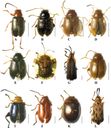Plagiodera
Plagiodera
Classification
- Phylum: Arthropoda
- Subphylum: Hexapoda
- Class: Insecta
- Order: Coleoptera
- Suborder: Polyphaga
- Superfamily: Chrysomeloidea
- Family: Chrysomelidae
- Subfamily: Chrysomelinae
- Tribe: Chrysomelini
- Subtribe: Chrysomelina
- Genus: Plagiodera
Pronunciation
How to pronounce Plagiodera: /ˌplæɡioʊˈdɛrə/
These audio files are automatically generated. While they are not always 100% accurate, they are a good starting point.
Images






Summary
Plagiodera is a genus of leaf beetles in the subfamily Chrysomelinae, known for their diverse species and widespread distribution. The genus includes both native and adventive species, with a notable prevalence of certain species in specific regions.
Physical Characteristics
Plagiodera beetles are characterized by their oblique neck and typically exhibit bright colors; some species have distinct black and yellow markings.
Identification Tips
Look for elongated bodies and distinctive coloration that varies among species. The presence of specific host plants can also aid in identification.
Habitat
Typically found in areas where host plants such as Populus and Salix grow, including riparian zones and forests.
Distribution
Plagiodera is nearly worldwide, with some species like P. versicolora being widespread in northeastern North America and others occurring primarily in the southwestern United States.
Diet
Most Plagiodera species are leaf-chewing herbivores, with specific diet preferences including Populus and Salix.
Life Cycle
Details on the specific life cycle of Plagiodera are not provided, but leaf beetles generally develop through egg, larval, pupal, and adult stages.
Reproduction
Reproductive behaviors are not specifically detailed. Generally, phytophagous beetles like Plagiodera lay eggs on or near host plants.
Predators
Natural predators include various birds, insects such as parasitic wasps, and other predators that target beetles.
Ecosystem Role
Plagiodera plays a role in its ecosystem as herbivores, contributing to plant population dynamics and serving as prey for predators.
Economic Impact
Some species can be considered pests of willows and poplars, potentially impacting forestry and horticulture.
Collecting Methods
- Hand collection from host plants
- Using nets to capture adults
- Light trapping methods
Preservation Methods
- Ethanol preservation
- Pinning specimens
- Drying specimens in a controlled environment
Similar Taxa
Misconceptions
Some may confuse Plagiodera with other beetles in the same family due to similar coloration and body shape.
Tags
- Chrysomelidae
- leaf beetles
- Plagiodera
- herbivores
- insecta